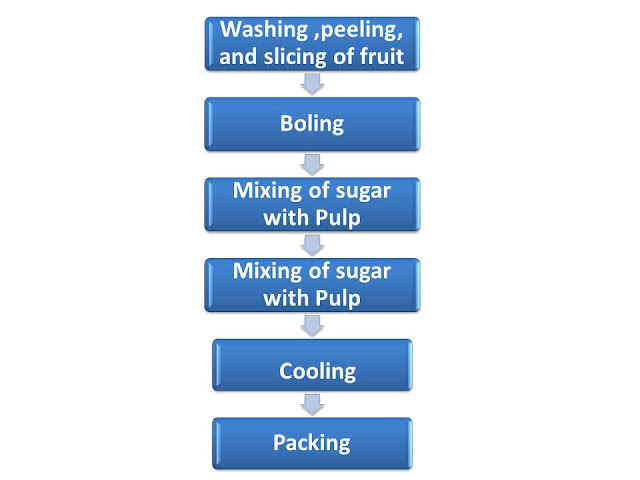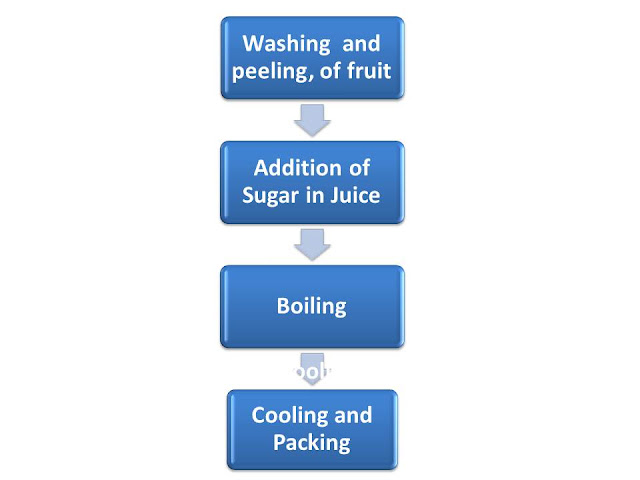How to start a jam – jelly producing unit ?
India is the second-largest producer of fruits and vegetables in the world Total area under the horticulture crops is approx 25.4 million hectares with a production of 310.74 million tonnes in 2018 -19 Out of which 97.97 million tonnes fruit crop production during the year 2018-2019 As per CIPHET (Central Institute of Post-Harvest Engineering and Technology) data 18% of India’s fruit and vegetable production which is approximately valued at Rs 13,300 crore is wasted annually due to post-harvest management and only 2% of the horticultural crops being used in value-added products
India has differing 15 agro-climatic conditions& 72 subzones, Six seasons, a variety of soil types, and plentiful precipitation. Because of this, our nation is an expected producer of high-esteem green produce. Organic products are an important wellspring of energy for individuals yet they are short-lived things. In any case, we can get ready en number of significant worth included items that have a bigger time span of usability.
In the whole food handling industry, jam and jelly are the most well-known item that you can produce without any problem. It needs the least machinery. Thus, the fixed capital cost is so less. Indeed, on the off chance that you have effectively a regular place of employment, at that point likewise you can think about this business to begin. Likewise, you can produce different items including natural product bar, juice, sauce, pickles from a similar unit.
This article incorporates an itemized jam jelly making business project test with machinery, cost, and crude materials. Likewise, it contains important contributions to beginning a jam jelly creation business with little speculation.
10 Steps in starting jam and jelly production business
STEP 1: Understand the product difference between jam and jelly
Jam and jelly are two unique items with various attributes and creation measures as well. In any case, the items have similitudes also. Both jam and jelly are made with fruits or fruit segments. Along these lines, you should comprehend the items appropriately first.
|
JAM
|
JELLY
|

Jam contains both sugar and pectin. It contrasts, nonetheless, in that genuine, squashed fruit or fruit mash is utilized rather than fruit juice. The squashed fruit is cooked down, for the most part with a touch of corrosive, until the fruit loses its shape and consistency. At that point, sugar and pectin are added to the combination.
Once cooled, the jam takes on a clear quality. Light actually goes through it, yet obvious pieces of fruit are suspended all through.
In light of jam’s incorporation of genuine fruit rather than juice, it might seem like the more beneficial alternative of the two. In any case, to qualify as a jam under the U.S. Food and Drug Administration (FDA) rules, an item should in any case contain over 55% sugar. Sugar is considered a preservative agent in every one of these blends, drawing out moisture from the fruit.
|

Jelly is sweet just like jam but it is firm, smooth, and gelatinous. Jelly is made up of cooked, clarified fruit juice, sugar, and pectin it does not contain enough naturally occurring pectin like jams. In the wake of cooking, yet before it has had the opportunity to cool, the blend is stressed through a fine work jelly pack to eliminate contaminations and solids.
Whenever it has cooled and cemented or solidified, you are left with a firm, straightforward fruit spread. Jelly is prominent for its thick gel, its gemstone-like clearness, and for the way that it is made with fruit juice rather than fruit.
|
STEP 2: Market Analysis
Jam and jelly are important food items as they upgrade the agreeability of food because of its taste and flavor. As they contain fruits, they supplement the food with nutrients and minerals. Henceforth, these items have generally excellent market potential.
The greater part of the families, cafés, different diners, clubs, lodgings and so forth devour jam and jelly consistently. Also, these are the significant selling items in numerous outlets like staple shops, departmental stores and so forth Furthermore, the interest for jam and jelly is developing a seemingly endless amount of time after year.
In the Indian market, you will discover a great deal of set up brands as smucker Kissan, Druk, Tops, Cremica, Patanjali and so on Be that as it may, the market is overwhelmingly for the little units delivering these items in the particular locale.
STEP 3: Prepare the Detailed Project Report
Setting up the business plan or project report is the initial step. Comprehensively, you have to make reference to the project diagram, business objective, specialized viewpoints, project financial aspects with cost and marketing plan. The specialized perspectives contain the crude material rundown, creation measure, and so on Also, you should specify where you will secure the crude materials.
Jam-Jelly Making Sample Project Cost;
sample project cost of an 15 tonnes jam and 15 tonnes jelly production is as follows ;
|
Particulars
|
Description (in Lacs )
|
|
Land
|
Own land
|
|
Building and civil work
|
7.25
|
|
Plant & Machinery
|
8.20
|
|
Fixed Assets
|
2.80
|
|
Pre -operative cost
|
2.25
|
|
Contingency & Escalation
|
1.20
|
|
Margin for Working Capital
|
1.75
|
|
Total
|
23.45
|
Toatal Cost is approximatly 23.45 lacs with some variation
STEP 4: Marketing Strategy;
The marketing plan of the proposed project may incorporate promotional scheemes like discounts scheemes, references, commercial, new product advancement, and so on Also, you can think about the attractive pakaging and tie-up with blulk purchasing houses like Hostels,Restra, Canteens etc
The adequacy of dissemination inclusion and practice is of vital significance in accomplishing the ideal jam and jelly deals. Subsequently, understanding the dissemination directs is critical all together for the maker to plan and actualize a successful conveyance procedure. In this way, you should give additional accentuation on building a potential distribution channel.
Furthermore, you can pick up the market share through improving retailer, and wholesaler edges. At last, you can consider using the media like transmission, newspapers, and furthermore the informal community stages to present the items and furthermore draw in more customers.
STEP 5: Business Registration and License ;
In our nation, starting a jam jelly making business even in little scope requires business enrollment. Aside from the sole proprietorship firm, you can enroll the association as LLP or Pvt Ltd or Ltd organization.
Subsequent to enrolling in the business, you should check the necessary business licenses and authorizations. Contingent upon the area, you should get Trade License. Apply for MSME Udyog Aadhaar enlistment on the web. Also, you should get the FSSAI enrollment. An FPO permit is important to begin a fruit preparing industry in India. As of now, GSTIN is a must in our nation for a business.
There is no significant contamination issue related to this industry aside from the removal of waste, Hence, you should oversee it fittingly. It is fitting that you apply for a “No Objection Certificate” from the State Pollution Control Board.
STEP 6: Arranging the Finance;
Presently, you should amass important money. On the off chance that you have your own capital, at that point, you don’t need to take any credit. Be that as it may, you can apply for the whole project fund from the banks or other money-related organizations. On the off chance that you have enough capital for the fixed cost, at that point also you can apply for working capital credit as an overdraft office.
STEP 7: Establishing the Unit ;
Area choice is the most important perspective in setting up the unit. Also, you should consider the utilities that you need in working the unit. You will need adequate water gracefully and power. By and large, the particular region prerequisite relies upon the unit size and creation yield your project. Nonetheless, you can begin a little scope activity from 1000 Sq Ft of secured territory.
STEP 8: Precuring the Machinery
1 )Pulper Machine ,2) Slicing Machine 3) Juice Extractor
4) Steam Jacketed Kettle 4) Blender/Grinder 5) Container Washing and Filling Machine 7) Baby Boiler 8)Cap Sealing Machine 9) Stirrers, SS Utensils, Burner, Weighing Scales, Hand Gloves 10) Mislleneous Tools and equipments 11)
Testing Equipment
STEP 9: Procurement of Raw Materials
To begin the business creation, you should obtain vital crude materials. The major consumables you require are fruits, sugar, gelatin, added substances, additives, food colors and so forth Also, you should acquire the packging consumables like plastic jars, pockets, names, cardboard boxes for external pressing, and glue tapes.
STEP 10: Jam and Jelly Production Process
Commercial Jam Production procedure
First of all, you should wash the new fruits in water and eliminate the skin. At that point cut or cut them into little pieces. Heat up these pieces with water. At that point, blend the suitable amount of sugar in with the mash. At the point when the temperature is around 60°C, include citrus extract, shading, quintessence, and so forth At that point mix this blend for some time. Subsequent to cooling, pack in the jugs.
The cycle stream diagram:
Commercial Jelly Production procedure
First of all, wash and strip the fruits. Feed them to the container of a juice extractor. In the wake of acquiring the juice, channel it. Certain fruits like rosella or guava need bubbling in water before removing juice. At that point, add the sugar to juice and heat up this blend to change over it in the jelly structure. Here, include gelatin, citrus extract, shading and so forth in the necessary amount. Bubbling is done work jelly-like development is gotten. In the wake of cooling, pack the jelly.
The cycle stream outline:
In the business jam jelly making business, you need to keep up the item quality. Notice the assembling date, amount, MRP, and expiry date on the name







